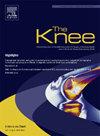双侧内侧开楔式胫骨高位截骨术的临床疗效及并发症
IF 1.6
4区 医学
Q3 ORTHOPEDICS
引用次数: 0
摘要
背景文献提供的关于双侧内侧开楔形高位胫骨截骨术(MOWHTO)的术后结果和并发症的证据有限。本研究旨在探讨同时双侧MOWHTO的临床结果和并发症。方法回顾性评估2011年12月至2021年1月期间同时行双侧MOWHTOs的36例患者(平均年龄58.6±8.2岁)的72个膝关节。同时双侧mowho采用锁定加压钢板。牛津膝关节评分(OKS)用于评估最后随访时的临床结果。术后系列x线平片和计算机断层扫描(CT)评估并发症(外侧铰链骨折(LHF)、骨不连和矫正缺失)。结果最后一次随访(2.0 ~ 11.1年),72例膝关节平均OKS为36.8±10.4。根据OKS的数据,42个膝盖(58.3%)被评为“优秀”,16个(22.2%)被评为“良好”,8个(11.1%)被评为“中等”,6个(8.3%)被评为“差”。72例膝关节中有11例发生LHFs(15.3%)。其中,术后x线平片和CT扫描发现了5例lhf(急性lhf),而6例仅在随访x线平片上发现(延迟性lhf)。1例迟发性LHFs患者矫正功能丧失。患者需要额外的手术治疗以实现截骨部位的骨愈合。结论双侧同时MOWHTO治疗双侧膝关节内侧骨性关节炎是一种可行的治疗方法。建议在短时间间隔内进行连续x线平片检查,以发现迟发性lhf,并预防固定失败和矫正丢失等并发症。本文章由计算机程序翻译,如有差异,请以英文原文为准。
Clinical outcome and complications after simultaneous bilateral medial opening-wedge high tibial osteotomy
Background
The literature provides limited evidence regarding postoperative outcomes and complications following simultaneous bilateral medial opening-wedge high tibial osteotomy (MOWHTO). This study aimed to investigate the clinical outcomes and complications associated with simultaneous bilateral MOWHTO.
Methods
We retrospectively evaluated 72 knees from 36 patients (mean age, 58.6 ± 8.2 years) who underwent simultaneous bilateral MOWHTOs between December 2011 and January 2021. Locking compression plates were used for simultaneous bilateral MOWHTOs. The Oxford Knee Score (OKS) was used to assess clinical outcomes at the last follow up. Complications (lateral hinge fracture (LHF), nonunion, and loss of correction) were evaluated using postoperative serial plain radiography and computed tomography (CT).
Results
At the last follow up (range, 2.0–11.1 years), the mean OKS for the 72 knees was 36.8 ± 10.4. According to the OKS, 42 knees (58.3%) scored ’excellent’, 16 (22.2%) scored ‘good’, eight (11.1%) scored ‘moderate’, and six (8.3%) scored ‘poor’. LHFs occurred in 11 of the 72 knees (15.3%). Among these, five LHFs were identified on postoperative plain radiographs and CT scans (acute LHFs), whereas six fractures were identified only on follow up plain radiographs (delayed LHFs). Loss of correction occurred in one patient with delayed LHFs. The patient required an additional surgical treatment to achieve bone healing at the osteotomy site.
Conclusion
Simultaneous bilateral MOWHTO is a viable treatment option for patients with bilateral medial osteoarthritis of the knee joint. Serial plain radiographs at short-term intervals are recommended to detect delayed LHFs and prevent complications such as fixation failure and loss of correction.
求助全文
通过发布文献求助,成功后即可免费获取论文全文。
去求助
来源期刊

Knee
医学-外科
CiteScore
3.80
自引率
5.30%
发文量
171
审稿时长
6 months
期刊介绍:
The Knee is an international journal publishing studies on the clinical treatment and fundamental biomechanical characteristics of this joint. The aim of the journal is to provide a vehicle relevant to surgeons, biomedical engineers, imaging specialists, materials scientists, rehabilitation personnel and all those with an interest in the knee.
The topics covered include, but are not limited to:
• Anatomy, physiology, morphology and biochemistry;
• Biomechanical studies;
• Advances in the development of prosthetic, orthotic and augmentation devices;
• Imaging and diagnostic techniques;
• Pathology;
• Trauma;
• Surgery;
• Rehabilitation.
 求助内容:
求助内容: 应助结果提醒方式:
应助结果提醒方式:


